Interactions between xenoestrogens and ketoconazole on hepatic CYP1A and CYP3A, in juvenile Atlantic cod (Gadus morhua)
- PMID: 15701172
- PMCID: PMC549046
- DOI: 10.1186/1476-5926-4-2
Interactions between xenoestrogens and ketoconazole on hepatic CYP1A and CYP3A, in juvenile Atlantic cod (Gadus morhua)
Abstract
BACKGROUND: Xenoestrogens and antifungal azoles probably share a common route of metabolism, through hepatic cytochrome P450 (CYP) enzymes. Chemical interactions with metabolic pathways may affect clearance of both xenobiotics and endobiotics. This study was carried out to identify possible chemical interactions by those substances on CYP1A and CYP3A, in Atlantic cod liver. We investigated effects of two xenoestrogens (nonylphenol and ethynylestradiol) and of the model imidazole ketoconazole, alone and in combination. RESULTS: Treatment with ketoconazole resulted in 60% increase in CYP1A-mediated ethoxyresorufin-O-deethylase (EROD) activity. Treatment with nonylphenol resulted in 40% reduction of CYP1A activity. Combined exposure to ketoconazole and nonylphenol resulted in 70% induction of CYP1A activities and 93% increase in CYP1A protein levels. Ketoconazole and nonylphenol alone or in combination had no effect on CYP3A expression, as analyzed by western blots. However, 2-dimensional (2D) gel electrophoresis revealed the presence of two CYP3A-immunoreactive proteins, with a more basic isoform induced by ketoconazole. Treatment with ketoconazole and nonylphenol alone resulted in 54% and 35% reduction of the CYP3A-mediated benzyloxy-4-[trifluoromethyl]-coumarin-O-debenzyloxylase (BFCOD) activity. Combined exposure of ketoconazole and nonylphenol resulted in 98% decrease in CYP3A activity. This decrease was greater than the additive effect of each compound alone. In vitro studies revealed that ketoconazole was a potent non-competitive inhibitor of both CYP1A and CYP3A activities and that nonylphenol selectively non-competitively inhibited CYP1A activity. Treatment with ethynylestradiol resulted in 46% decrease in CYP3A activity and 22% decrease in protein expression in vivo. In vitro inhibition studies in liver microsomes showed that ethynylestradiol acted as a non-competitive inhibitor of CYP1A activity and as an uncompetitive inhibitor of CYP3A activity. CONCLUSIONS: Ketoconazole, nonylphenol and ethynylestradiol all interacted with CYP1A and CYP3A activities and protein expression in Atlantic cod. However, mechanisms of interactions on CYP1A and CYP3A differ between theses substances and combined exposure had different effects than exposure to single compounds. Thus, CYP1A and CYP3A mediated clearance may be impaired in situations of mixed exposure to those types of compounds.
Figures
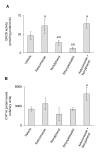
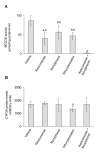
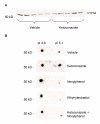
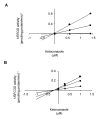
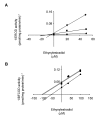

Similar articles
-
Ketoconazole, an antifungal imidazole, increases the sensitivity of rainbow trout to 17alpha-ethynylestradiol exposure.Aquat Toxicol. 2008 Jan 31;86(2):256-64. doi: 10.1016/j.aquatox.2007.11.006. Epub 2007 Nov 13. Aquat Toxicol. 2008. PMID: 18082278
-
Effects of North Sea oil and alkylphenols on biomarker responses in juvenile Atlantic cod (Gadus morhua).Aquat Toxicol. 2006 Jun 1;78 Suppl 1:S73-8. doi: 10.1016/j.aquatox.2006.02.019. Epub 2006 Apr 18. Aquat Toxicol. 2006. PMID: 16621063
-
Effects of alkylphenols on CYP1A and CYP3A expression in first spawning Atlantic cod (Gadus morhua).Aquat Toxicol. 2004 May 12;67(4):303-13. doi: 10.1016/j.aquatox.2003.12.007. Aquat Toxicol. 2004. PMID: 15084407
-
Effects of the antifungal imidazole ketoconazole on CYP1A and CYP3A in rainbow trout and killifish.Environ Toxicol Chem. 2004 May;23(5):1326-34. doi: 10.1897/03-155. Environ Toxicol Chem. 2004. PMID: 15180387
-
New insights of CYP1A in endogenous metabolism: a focus on single nucleotide polymorphisms and diseases.Acta Pharm Sin B. 2020 Jan;10(1):91-104. doi: 10.1016/j.apsb.2019.11.016. Epub 2019 Dec 2. Acta Pharm Sin B. 2020. PMID: 31998606 Free PMC article. Review.
Cited by
-
Relationships between Isomeric Metabolism and Regioselective Toxicity of Hydroxychrysenes in Embryos of Japanese Medaka (Oryzias latipes).Environ Sci Technol. 2023 Jan 10;57(1):539-548. doi: 10.1021/acs.est.2c06774. Epub 2022 Dec 27. Environ Sci Technol. 2023. PMID: 36573895 Free PMC article.
-
De Facto Water Reuse: Bioassay suite approach delivers depth and breadth in endocrine active compound detection.Sci Total Environ. 2020 Jan 10;699:134297. doi: 10.1016/j.scitotenv.2019.134297. Epub 2019 Sep 4. Sci Total Environ. 2020. PMID: 31683213 Free PMC article.
-
New Conceptual Toxicokinetic Model to Assess Synergistic Mixture Effects between the Aromatic Hydrocarbon β-Naphthoflavone and the Azole Nocodazole on the CYP1A Biomarker in a Fish Cell Line.Environ Sci Technol. 2020 Nov 3;54(21):13748-13758. doi: 10.1021/acs.est.0c04839. Epub 2020 Oct 15. Environ Sci Technol. 2020. PMID: 33054185 Free PMC article.
-
Alteration of cytochrome P450 1 regulation and HSP 70 level in brain of juvenile common carp (Cyprinus carpio) after chronic exposure to tributyltin.Fish Physiol Biochem. 2016 Feb;42(1):287-94. doi: 10.1007/s10695-015-0136-8. Epub 2015 Sep 23. Fish Physiol Biochem. 2016. PMID: 26400268
-
Azole affinity of sterol 14α-demethylase (CYP51) enzymes from Candida albicans and Homo sapiens.Antimicrob Agents Chemother. 2013 Mar;57(3):1352-60. doi: 10.1128/AAC.02067-12. Epub 2012 Dec 28. Antimicrob Agents Chemother. 2013. PMID: 23274672 Free PMC article.
References
-
- Castillo LE, Ruepert C, Solis E. Pesticide residues in the aquatic environment of banana plantation areas in the North Atlantic zone of Costa Rica. Environ Toxicol Chem. 2000;19:1942–1950.
-
- Van den Bossche HKL, Moereels H. P450 inhibitors of use in medical treatment: focus on mechanisms of action. Pharmacol Ther. 1995;67:79–100. - PubMed
-
- Kan PB, Hirst MA, Feldman D. Inhibition of steroidogenic cytochrome P-450 enzymes in rat testis by ketoconazole and related imidazole anti-fungal drugs. J Steroid Biochem. 1985;23:1023–1029. - PubMed
-
- Latrille F, Charuel C, Lodola A. A comparative study of the effects of ketoconazole and fluconazole on 17-β estradiol production by rat ovaries in vitro. Res Commun Chem Pathol Pharmacol. 1989;64:173–176. - PubMed
-
- Venkatakrishnan K, von Moltke LL, Greenblatt DJ. Effects of the antifungal agents on oxidative drug metabolism: clinical relevance. Clin Pharmacokinet. 2000;38:111–180. - PubMed
LinkOut - more resources
Full Text Sources
